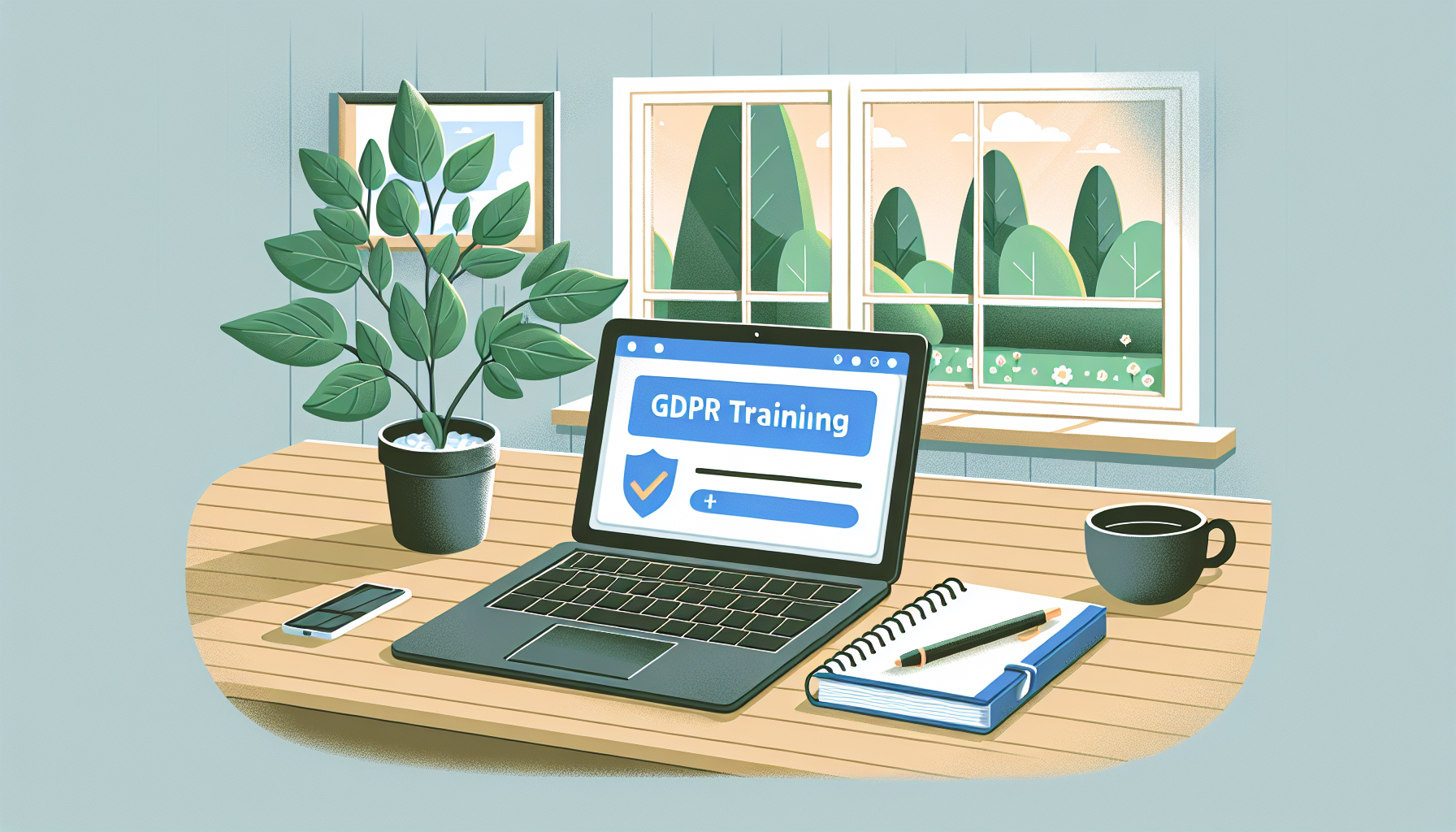Navigating the world of GDPR compliance can feel like trying to solve a Rubik’s Cube blindfolded, especially for course creators who just want to focus on educating their audience. You might be wondering what all the fuss is about or feeling overwhelmed by the legal jargon. Trust me, you’re not alone!
But hang tight—if you stick with me through this guide, I promise you’ll gain a clear understanding of GDPR compliance and discover how it can not only protect your business but also build trust with your students.
We’ll break down the essentials, from the key principles of GDPR to the types of training available, so you can hit the ground running and ensure your course materials are compliant and secure. Let’s dive in!
Key Takeaways
- GDPR compliance safeguards user data and builds trust, making it vital for course creators.
- Understand key GDPR principles: transparency, purpose limitation, data minimization, accuracy, and storage limitations.
- Appoint a Data Protection Officer or assign responsibilities within your team for effective compliance.
- Train all staff handling personal data on GDPR principles to ensure understanding and compliance.
- Explore diverse training options, including online courses and workshops, to fit your team’s needs.
- Keep training content relevant to course creation, focusing on best practices and data handling.
- Ensure certifications are documented for compliance audits and training completion tracking.
- Schedule regular refresher courses to keep the team updated on GDPR best practices.
- Implement GDPR effectively by auditing existing processes and creating clear data management guidelines.
- Stay informed on GDPR updates and adjust training and policies as necessary.

1. Understand Why GDPR Compliance is Important for Course Creators
GDPR compliance is crucial for course creators because it protects user data and builds trust with your audience.
When participants know their information is secure, they’re more likely to engage with your content.
Consider this: over 2,000 fines have been issued for GDPR noncompliance since 2018, highlighting the risks of ignoring these regulations.
For instance, Vinted faced a hefty €2,385,276 fine for not adequately fulfilling data subjects’ rights.
Staying compliant not only helps you avoid penalties but also positions your course as a trustworthy resource in the eLearning market.
2. Learn the Key Principles of GDPR Compliance
Understanding the key principles of GDPR is essential for keeping your course compliant.
First, there’s the principle of lawfulness, fairness, and transparency, which means you need to be clear about how you collect and use data.
Then there’s purpose limitation—only collect data for specific, legitimate purposes.
Data minimization follows, advising you to gather only what’s necessary.
Also, don’t forget the accuracy principle; ensure that the data you hold is up-to-date and correct.
Finally, consider storage limitation and integrity and confidentiality, where you must only keep data as long as necessary and safeguard it to prevent breaches.
3. Identify Roles and Responsibilities for GDPR Compliance
Identifying roles and responsibilities is key to a successful GDPR compliance strategy.
Start with appointing a Data Protection Officer (DPO) if your course handles large amounts of personal data.
This person oversees data processing activities and ensures compliance with GDPR.
In smaller setups, tasks can be delegated to team members responsible for data management and security.
Make sure everyone involved understands their role—whether it’s collecting data, processing it, or responding to data requests.
Creating a clear data protection policy will help set these responsibilities, boosting accountability across your team.

4. Determine Who Needs GDPR Training in Your Organization
Identifying who needs GDPR training is crucial for ensuring compliance across your course creation process.
Everyone involved in handling personal data, from content creators to administrative staff, should receive training.
Your marketing team often interacts with user data, so they need to understand consent and data protection principles.
It’s also important to train course instructors on how to handle participant data responsibly.
Finally, keep in mind that any new hires should go through GDPR training as part of their onboarding process.
Regularly assessing needs will keep your team updated on any changes in GDPR regulations.
5. Explore Different Types of GDPR Training Courses Available
There are several types of GDPR training courses available, catering to different needs and learning styles.
You can find online courses, in-person workshops, and even interactive webinars that fit into busy schedules.
Consider courses that offer certification upon completion, as they can add credibility to your team’s understanding.
Don’t shy away from free resources either; many organizations provide detailed guides and webinars at no cost.
You might also want to look into tailored training that focuses on specific aspects of GDPR relevant to your course niche.
6. Consider Online GDPR Training Options for Flexibility
Online GDPR training offers the flexibility that course creators need, especially those juggling multiple responsibilities.
Many platforms provide self-paced courses that allow your team to learn at their convenience.
This option is particularly beneficial for busy professionals who may struggle to attend in-person sessions.
Make sure to choose an online course that is frequently updated to reflect the latest GDPR regulations.
You can often find reviews and testimonials to help you pick the right online training for your needs.
7. Review Typical Course Content and Learning Objectives
When evaluating GDPR training courses, take a close look at the course content and learning objectives.
Typical content includes an overview of GDPR principles, data subjects’ rights, and best practices for data handling.
Look for practical examples that relate specifically to course creation and eLearning environments.
This can include case studies about other organizations facing penalties for non-compliance.
Learning objectives should clearly articulate what attendees will know and be able to do once they complete the course.
8. Understand Certification and Documentation Requirements
Certification and proper documentation are key components of a comprehensive GDPR training strategy.
Many organizations require certificates to ensure that staff are aware of their data protection responsibilities.
A certificate can also serve as proof of compliance during audits or inspections.
Ensure your team keeps their certificates in a centralized location for easy retrieval when required.
Documenting training completion is critical, and tracking who has completed GDPR courses will help ensure ongoing compliance.
9. Schedule Regular GDPR Refresher Training for Your Team
Regular refresher training is essential to keep GDPR knowledge current among your team members.
Consider scheduling annual or bi-annual training sessions to ensure everyone stays updated on best practices.
You can use quizzes or short assessments at the end of each training to reinforce learning.
Reviewing recent news or changes related to GDPR can also spark valuable discussions during these sessions.
Regular refresher courses not only keep your organization compliant but also strengthen a culture of data protection.
10. Take Steps to Implement GDPR Compliance Effectively
Implementing GDPR compliance effectively requires a clear action plan and teamwork.
Start with a comprehensive audit of your current data protection processes to identify gaps or weaknesses.
Next, develop clear guidelines on data collection, storage, and sharing practices.
Engage your entire team in the compliance process; this ensures everyone understands their role in data protection.
Make sure to stay informed about GDPR updates and adjust your training and policies accordingly.
Finally, consider reaching out to professionals for advice if needed, as they can provide insights tailored to your unique situation.
FAQs
GDPR compliance is essential for course creators to protect personal data, avoid hefty fines, and build trust with users. Non-compliance can lead to legal repercussions and damage to reputation, making it critical for business sustainability.
The key principles of GDPR include data minimization, purpose limitation, accuracy, storage limitation, integrity, confidentiality, and accountability. These principles guide organizations in handling personal data responsibly and legally.
All employees who handle personal data should receive GDPR training, including marketing, HR, and customer service teams. It ensures everyone understands their roles and responsibilities in protecting personal information.
GDPR training courses vary from online self-paced courses to instructor-led workshops. Topics typically cover rights of individuals, organization responsibilities, and practical scenarios to apply GDPR effectively.
